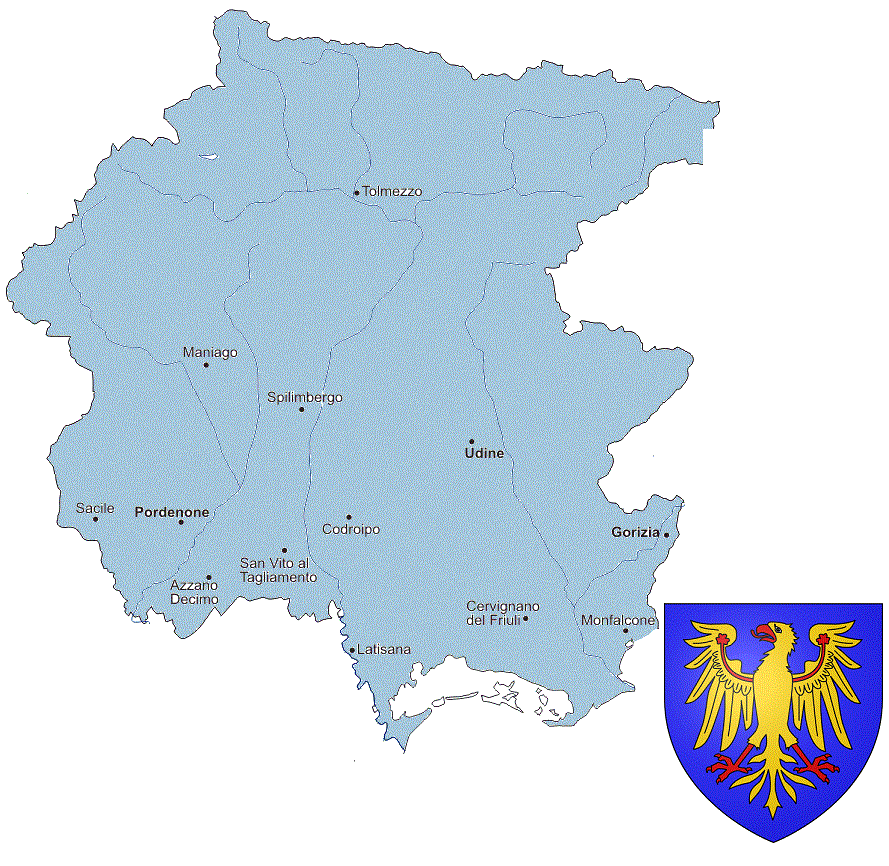History of Friuli
Geography:
Friuli is part of the region of Friuli Venezia Giulia (F.V.G.) in the North-Eastern corner of Italy. F.V.G shares its borders with Slovenia to the East, Austria to the North, and the Veneto region to the West.
Language:
The main characteristic distinguishing Friuli from the rest of the F.V.G Region and Italy is the Friulian language, which is spoken by about 1.5 million speakers both in Friuli and abroad.
Just like Catalan in Spain, Friulian is a minority language recognized as such by the European Union. Although Italy has also recognized it as a minority language, it does not promote its teaching. All Friulians in Friuli speak Italian, the official language of Italy, and Friulian. There are also two other linguistic minorities: German speakers in Carnia and a larger group of Slovenian speakers in the area of the Natisone River.
Early History:
During early Roman times Friuli was inhabited by the Carnics, a Celtic tribe, who had crossed the Alps and settled in North-eastern Italy. The Romanization of Friuli was ensured by the establishment of the ‘Forum Iulii’, today Zuglio, near Cividale. ‘Forum Iulii’ eventually came to be known as ‘Friuli’.
In 181 B.C, the Romans transformed the existing town of Aquileia into the capital of the tenth Roman region. Eventually, Aquileia became the second most important city of the Roman Empire. Tactically, this region was extremely important to the Empire due to its strategic location. The Romans quickly realized that by settling the region with Roman citizens and Legionnaires they could ensure the defence of the territory. Indeed, this tenth region attained considerable importance, not only militarily, but also, culturally, commercially and politically.
Christianity arrived early in the area and eventually the Patriarch of Aquileia became so powerful that it was in direct competition with the Papacy in Rome. By the 10th century Friuli had already developed its own lingua franca, which was different from Latin.
The Duchy of Friuli was created as an independent state on April 3, 1077 by a decree of Henry IV who conferred on Sigeard, the Patriarch of Aquileia, complete political and military power over the area. It is for this reason that Friulians celebrate the creation of their homeland on April 3, la Fieste dal Popul Furlan.
As Patriarch, Sigeard already enjoyed religious supremacy over the region, which was then much larger than the present-day Friuli Venezia Giulia. The Duchy was also granted the right to coin its own currency. It should also be noted that historical documents confirm that there was a fully functional Parliament in Friuli as far back as the mid XIII century.
Being a border region, Friuli has experienced much turmoil and political upheavals during its history. Romans, Huns, Franks, Longobards, Venetians and Austrians all contributed to the history of the ‘nation’.
Few are aware that, during the second WW, the Nazis had ‘given’ parts of Friuli to the Cossacks. Between October 1944 and April 1945 about 50,000 Cossacks were transferred to an area of the Friuli Region renamed 'Kosakenland in Nord Italien' by the Nazis. This was in exchange for helping the Nazis repress the ever-mounting partisan guerrilla activity against the Third Reich.
More recently, during the Cold War, Friuli became a strategic region for the defence of the West. This area was host to thousands of NATO troops stationed close to the iron curtain in order to stop a possible communist invasion. The NATO Air Base of Aviano, located in the western part of Friuli, was as a strategic base defending southern Europe against communism.
Friuli earthquake:
In 1976 in the aftermath of the massive earthquake that afflicted Friuli, Canadians of Friulian ancestry successfully rallied aid and fund raising sending brigades of Friulian Canadians to assist with the reconstruction.
The Canadian government quickly followed this lead and sent logistical and financial assistance to deal with the tragedy. Canadian logistical support was unfortunately marred by the untimely death of Captain Ronald G. (Buck) McBride, pilot of a tactical helicopter stationed at CFB LAHR, who was killed when his aircraft crashed during rescue operations near the town of Venzone. Friulians immortalized his act of heroism by naming one of the piazzas of Venzone in his honour, and several streets in Friuli are now named in his honour.
Points of interest:
In 1981 the Fogolârs Federation Canada brought a delegation of First Nations representatives to Friuli. On this occasion, a totem pole representing Canada was donated to the city of Udine. It stands proudly nestled amongst Canadian maples in a piazza of Udine.
There are also other ties between Canada and Friuli such as the agreement between the Princess Margaret Hospital and the Centro Oncologico di Riferimento of Aviano (CRO) signed in 2007. The PMH and the CRO have joined forces to carry out cancer research.
In 2009 the Federation was invited and delivered a presentation for Friulian business and academic leaders in Udine entitled “Multiculturalism as a resource for business”.
In 2012, the Canadian Government opened a Consulate in Udine, Friuli, and named Mr. Primo Di Luca, Honorary Consul of Canada for Friuli-Venezia Giulia. This action by the Canadian government is instrumental in encouraging business exchanges.
While political and business leaders of Canada and the Friuli region undertake to expand commercial and academic relations, the Fogolârs Federation, following such leads, has been instrumental in bringing together business leaders from Canada and Friuli. It has also assisted in realizing academic agreements between the University of Udine (Friuli) and Canadian universities.
Cemetery of Redipuglia:
Redipuglia, described by the Italians as a “Sacred Cemetery”, is a most important symbolic Italian WWI cemetery. 100 000 of the nearly 700 000 Italian soldiers killed in the North Eastern Italian WWI arena are buried here. The then Dominion of Canada and Great Britain were allies of Italy during the WWI.
